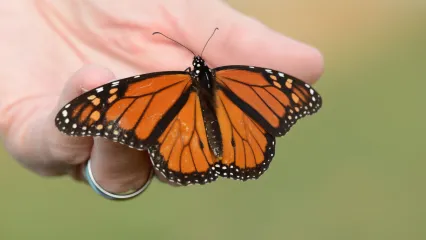
Description
The American burying beetle is a large, boldly-marked beetle with an overall black color, and four red-orange markings on its back. It also has a prominent red-orange coloration on the pronotum, or portion of the back between the head and the wing covers. It is the largest North American species of carrion beetle, reaching between one and two inches in length.
The range wide decline of this species has been attributed to multiple factors, though the primary causes are habitat fragmentation and human development. The invasion of the red imported fire ant is thought to have the potential to impact American burying beetles, either through direct mortality or by competition for prey. Other changes that may have contributed to the species’ range contraction include the introduction of invasive species and reduced carcass availability from changes in bird and mammal communities. The Wildlife Diversity Program has funded research and recovery grants for the American burying beetle through ESA Section 6 funding. One project was conducted between 1990 and 1994 by the University of Oklahoma and was focused on understanding habitat use and genetic variability of the species in the state. Another project was conducted in 2005 and focused on examining habitat selected by the beetles for reproduction. In 2017, a new project will fund research to assess the impacts of different agricultural practices, such as grazing and pecan farming, on the beetle. Multiple surveys for this species have been conducted on public lands by Oklahoma State University through the State Wildlife Grants Program. These survey results are being compared to historic location records to determine changes in beetle density and distribution through time. Many wildlife management practices are beneficial to maintaining habitat for this species. This includes activities such as prescribed fire, selective tree thinning and invasive species control.
Size
1-1.5 inches in length.
Habitat
Historical records for the American burying beetle are in at least twenty Oklahoma counties. It is currently known to occur in at least 29 counties in the eastern portion of the state.The highest densities of American burying beetles seem to be in open, oak-hickory forests with native grass cover. Populations also occur in both closed-canopy forest and tallgrass prairie habitats. The two limiting factors for this beetle are access to suitable soils for carcass burial and a diverse small mammal or bird community for prey.
Life Cycle
This beetle is nocturnal and spends the daylight hours buried in loose soil. It feeds almost exclusively on the carcasses of dead animals, especially small birds and rodents. They are unique among insects in that they exhibit a large amount of parental care for their offspring. When American burying beetles prepare for reproduction, males and females seek out carcasses weighing between 3-7 ounces. After the carcass has been located, the pair begins to defend it from other burying beetles and competing scavengers. They then will bury the carcass in the soil, removing all fur or feathers from the body. The female lays 12-18 eggs near the carcass. When the eggs hatch, larvae feed on the carcass until they pupate and emerge as adults at approximately two months of age.


